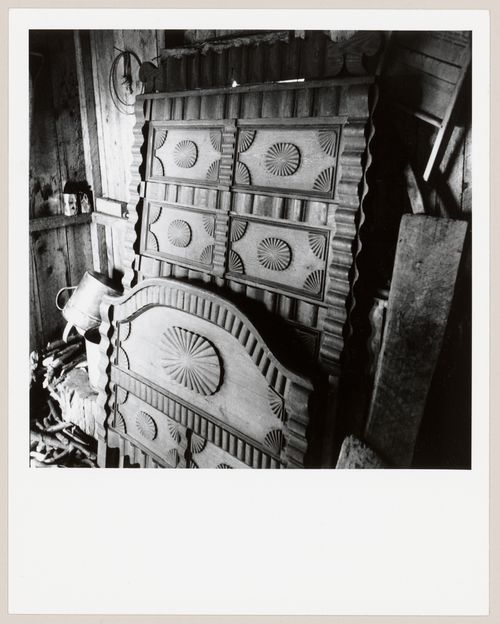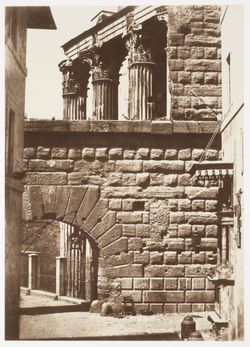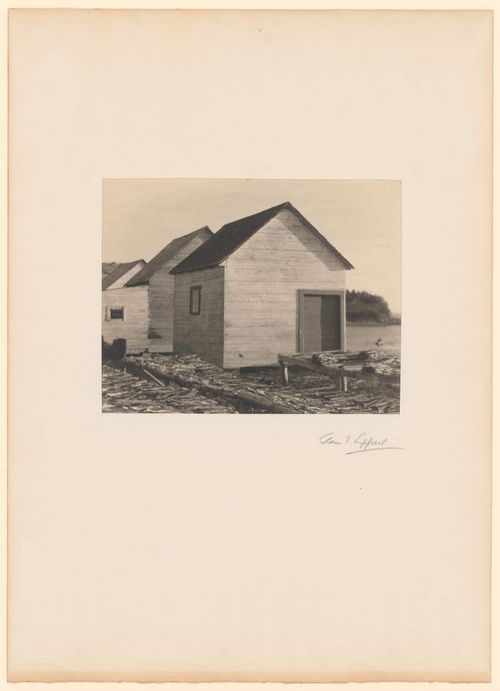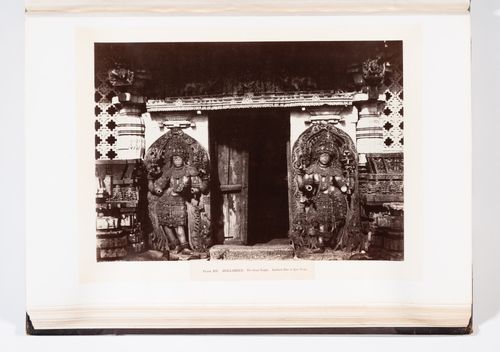PH1980:0505
Description:
- The headboard and a footboard are in Servule Morneau's house. - The constructed alternate title is the title that appeared on the label copy in the CCA exhibition "Parcours de photographes visiteurs au Québec: Sipprell, Moser, Volkerding et Kawamata" (see exhibition file "Four Photographers Visit Québec").
architecture, sculpture
1950
Détail d'un châlit sculpté par Servule Morneau, artisan de Saint-Jean-Port-Joli, Québec
Actions:
PH1980:0505
Description:
- The headboard and a footboard are in Servule Morneau's house. - The constructed alternate title is the title that appeared on the label copy in the CCA exhibition "Parcours de photographes visiteurs au Québec: Sipprell, Moser, Volkerding et Kawamata" (see exhibition file "Four Photographers Visit Québec").
architecture, sculpture
In this exhibition, a selection of contemporary publications and critical investigations lay the groundwork through which to explore the relationship between travel and design today, while selected items from the CCA collection offer a historiography of tourism.
12 December 2019 to 15 November 2020
Detour: Alternative Readings of Travel
Actions:
Description:
In this exhibition, a selection of contemporary publications and critical investigations lay the groundwork through which to explore the relationship between travel and design today, while selected items from the CCA collection offer a historiography of tourism.
Nuit blanche 2018: On Air
On the occasion of the fifteenth Nuit blanche à Montréal, the CCA hosts a mini-festival of television inspired by its current exhibition The University Is Now on Air: Broadcasting Modern Architecture
3 March 2018, 3pm to 1am
Nuit blanche 2018: On Air
Actions:
Description:
On the occasion of the fifteenth Nuit blanche à Montréal, the CCA hosts a mini-festival of television inspired by its current exhibition The University Is Now on Air: Broadcasting Modern Architecture
archives
Level of archival description:
Fonds
AP074
Synopsis:
The Catherine Chard Wisnicki fonds contains photographs dating from about 1947, of a house project in West Vancouver which Chard Wisnicki, the first female graduate of the McGill School of Architecture, was assistant architect. The fonds also contains a videocassette recording of an interview with Chard Wisnicki from 1995, and one textual document from 1997.
[ca. 1947], 1995, 1997
Catherine Chard Wisnicki fonds
Actions:
AP074
Synopsis:
The Catherine Chard Wisnicki fonds contains photographs dating from about 1947, of a house project in West Vancouver which Chard Wisnicki, the first female graduate of the McGill School of Architecture, was assistant architect. The fonds also contains a videocassette recording of an interview with Chard Wisnicki from 1995, and one textual document from 1997.
archives
Level of archival description:
Fonds
[ca. 1947], 1995, 1997
PH1983:0259
Description:
- Alternate title "Le séchage de la morue, Gaspésie" is the title that appeared on the label copy in the CCA exhibition "Parcours de photographes visiteurs au Québec: Sipprell, Moser, Volkerding et Kawamata". Alternate title "Drying Cod, Garpé Peninsula" is the artist's title as indicated on the list of objects for the same exhibition (see Exhibition Files, s.v. "Four Photographers Visit Québec").
architecture
ca. 1929
View of sheds and codfish drying on racks, Gaspé Peninsula, Québec, Canada
Actions:
PH1983:0259
Description:
- Alternate title "Le séchage de la morue, Gaspésie" is the title that appeared on the label copy in the CCA exhibition "Parcours de photographes visiteurs au Québec: Sipprell, Moser, Volkerding et Kawamata". Alternate title "Drying Cod, Garpé Peninsula" is the artist's title as indicated on the list of objects for the same exhibition (see Exhibition Files, s.v. "Four Photographers Visit Québec").
architecture
Environment: Approaches for Tomorrow broaches issues such as energy consumption and natural resources, the question of limiting humanity’s control of the environment, the search for renewable resources, and the optimal means to employ them. Through the work of French horticultural engineer and landscape architect Gilles Clément and Swiss architect Philippe Rahm, the(...)
Main galleries
18 October 2006 to 10 June 2007
Environment: Approaches for Tomorrow
Actions:
Description:
Environment: Approaches for Tomorrow broaches issues such as energy consumption and natural resources, the question of limiting humanity’s control of the environment, the search for renewable resources, and the optimal means to employ them. Through the work of French horticultural engineer and landscape architect Gilles Clément and Swiss architect Philippe Rahm, the(...)
Main galleries
Series
Projects and events
AP170.S3
Description:
Series 3, Projects and events, 1992 – 2014, documents each major installation of the Hyposurface project and consists of more than 10,000 digital files. These files include exhibition layout planning, Aegis simulator software demonstrating Hyposurface, event photographs and video, and ACDC and Aegis software related to specific events. This series also includes the majority of the material Paul Steenhuisen G5 Mac computer and the related Hyposurface audio installations. The bulk of the materials dates from 2000 – 2007. Events represented include Venice Biennale (Venice, 2000); CeBIT Technology Fair (Hannover, Germany, 2002); International Manufacturing Technology Show (IMTS, Chicago, 2006); BIO exhibition (Boston, 2007); and the Canadian Centre for Architecture (Montreal, 2013-2014). This series also contains a number of unidentified projects, including projects in Brisbane, Australia; Amsterdam, the Netherlands; and possibly Russia and Spain. There is also video documentation related to a Hyposurface proposal for BMW, as well as what appears to be a tour of Kuka Robotics staff through dECOi’s laboratory. This series contains nearly 3100 Aegis pattern files, which are identifiable by their file extension (.aeg). An additional 3100 files are plain text files, executable files, or an unidentified format, and appear to relate to other dECOi software. This series notably contains more than 2000 audio files related to the Paul Steenhuisen installations. The rest of the series contains largely still images and video, as well as a small number of AutoCAD and Rhino files. This series overlaps with Series 2: Software and related documentation. This series contains only software related to a specific project or event, while Series 2 contains software generally related to Hyposurface.
1992 - 2014
Projects and events
Actions:
AP170.S3
Description:
Series 3, Projects and events, 1992 – 2014, documents each major installation of the Hyposurface project and consists of more than 10,000 digital files. These files include exhibition layout planning, Aegis simulator software demonstrating Hyposurface, event photographs and video, and ACDC and Aegis software related to specific events. This series also includes the majority of the material Paul Steenhuisen G5 Mac computer and the related Hyposurface audio installations. The bulk of the materials dates from 2000 – 2007. Events represented include Venice Biennale (Venice, 2000); CeBIT Technology Fair (Hannover, Germany, 2002); International Manufacturing Technology Show (IMTS, Chicago, 2006); BIO exhibition (Boston, 2007); and the Canadian Centre for Architecture (Montreal, 2013-2014). This series also contains a number of unidentified projects, including projects in Brisbane, Australia; Amsterdam, the Netherlands; and possibly Russia and Spain. There is also video documentation related to a Hyposurface proposal for BMW, as well as what appears to be a tour of Kuka Robotics staff through dECOi’s laboratory. This series contains nearly 3100 Aegis pattern files, which are identifiable by their file extension (.aeg). An additional 3100 files are plain text files, executable files, or an unidentified format, and appear to relate to other dECOi software. This series notably contains more than 2000 audio files related to the Paul Steenhuisen installations. The rest of the series contains largely still images and video, as well as a small number of AutoCAD and Rhino files. This series overlaps with Series 2: Software and related documentation. This series contains only software related to a specific project or event, while Series 2 contains software generally related to Hyposurface.
Series
1992 - 2014
archives
Level of archival description:
Fonds
Cedric Price fonds
AP144
Synopsis:
The Cedric Price fonds documents the personal activities and professional practice of architect Cedric Price, and includes his student work and architectural and urban planning projects. The fonds also contains records that document Cedric Price's teaching, publication, and exhibition activities. The archive comprises over 200 projects, from Price's student work in the 1950s at the University of Cambridge and the Architectural Association to projects he undertook as late as 2000. Key projects that are represented include New Aviary (1960-1966), Fun Palace (1961-1974), Potteries Thinkbelt (1963-1967), Inter-Action Centre (1971-1979), Generator (1976-1980), and Magnet (1995-1996).
1903-2006, predominant 1953-2000
Cedric Price fonds
Actions:
AP144
Synopsis:
The Cedric Price fonds documents the personal activities and professional practice of architect Cedric Price, and includes his student work and architectural and urban planning projects. The fonds also contains records that document Cedric Price's teaching, publication, and exhibition activities. The archive comprises over 200 projects, from Price's student work in the 1950s at the University of Cambridge and the Architectural Association to projects he undertook as late as 2000. Key projects that are represented include New Aviary (1960-1966), Fun Palace (1961-1974), Potteries Thinkbelt (1963-1967), Inter-Action Centre (1971-1979), Generator (1976-1980), and Magnet (1995-1996).
archives
Level of archival description:
Fonds
1903-2006, predominant 1953-2000
Project
AP198.S1.1997.PR02
Description:
Project records document the design process for OCEAN North’s competition entry for the Jyväskylä Music and Arts Centre in 1997. The project was titled Terra Cultura by OCEAN North. The international competition called to create a multi-usage space that would include a venue for the symphonic orchestra, a music school, exhibition spaces, and the possibility to host a variety of small cultural events in the Finnish city of Jyväskylä. The proposed site is in the center of the town, across the street from the Jyväskylä city church and its park, and nearby buildings designed by Alvar Aalto. OCEAN North’s concept presents a topological surface as an extension of the surrounding urban scape with two masses that would host the formal functions of the building (concert hall, music school, exhibition halls). The two volumes, or raised blocks, are divided along a diagonal elevated space, which is the extension of the ground’s topological surface filled and dubbed “Liquid Flow Space” by the design team. In their interview with Greg Lynn, Johan Bettum and Kivi Sotamaa mentioned that the idea for Jyväskylä was that it was a cloud. Digital files, in particular, show the process to achieve the projected design. Drawings provide views of streamed particles and of resulting peels. They also include plans, elevations and axonometric views of the structure. Most files are raster or vector images, likely saved from CAD software. A few files are in CAD formats such as Microstation, 3D Studio and form*Z. Digital files also present sine wave analysis and resulting charts for each component of the program. The analysis and charts present the relationships between various components of the building’s program such as the Art Museum, the Concert Halls, the technical space, and the Common facilities. These files are raster images and spreadsheets. Photographs of the site in Jyväskylä and of models built by OCEAN North were digitized and are included with the digital working files. Physical drawings are chiefly floor plans for the building, but also include sections and sketches. Finally, project files include photographic prints of two built models. One of these models, a small model of the conceptual masses of the building structure, is itself in the archive. Photographs show the model in the context of a city scape model. The second model, not part of the archive at CCA, was built at a bigger scale and was an intricate cardboard and wooden stick structure. Sources: Softspace: from a representation of form to a simulation of space, Edited by Sean Lally and Jessica Young. London, New York: Routledge, 2007. Greg Lynn, ed. Archaeology of the Digital 17: OCEAN North, Jyväskylä Music and Arts Centre, Montréal: Canadian Centre for Architecture, 2017. ePub.
1997
Terra Cultura – Jyväskylä Music and Arts Centre, international competition entry
Actions:
AP198.S1.1997.PR02
Description:
Project records document the design process for OCEAN North’s competition entry for the Jyväskylä Music and Arts Centre in 1997. The project was titled Terra Cultura by OCEAN North. The international competition called to create a multi-usage space that would include a venue for the symphonic orchestra, a music school, exhibition spaces, and the possibility to host a variety of small cultural events in the Finnish city of Jyväskylä. The proposed site is in the center of the town, across the street from the Jyväskylä city church and its park, and nearby buildings designed by Alvar Aalto. OCEAN North’s concept presents a topological surface as an extension of the surrounding urban scape with two masses that would host the formal functions of the building (concert hall, music school, exhibition halls). The two volumes, or raised blocks, are divided along a diagonal elevated space, which is the extension of the ground’s topological surface filled and dubbed “Liquid Flow Space” by the design team. In their interview with Greg Lynn, Johan Bettum and Kivi Sotamaa mentioned that the idea for Jyväskylä was that it was a cloud. Digital files, in particular, show the process to achieve the projected design. Drawings provide views of streamed particles and of resulting peels. They also include plans, elevations and axonometric views of the structure. Most files are raster or vector images, likely saved from CAD software. A few files are in CAD formats such as Microstation, 3D Studio and form*Z. Digital files also present sine wave analysis and resulting charts for each component of the program. The analysis and charts present the relationships between various components of the building’s program such as the Art Museum, the Concert Halls, the technical space, and the Common facilities. These files are raster images and spreadsheets. Photographs of the site in Jyväskylä and of models built by OCEAN North were digitized and are included with the digital working files. Physical drawings are chiefly floor plans for the building, but also include sections and sketches. Finally, project files include photographic prints of two built models. One of these models, a small model of the conceptual masses of the building structure, is itself in the archive. Photographs show the model in the context of a city scape model. The second model, not part of the archive at CCA, was built at a bigger scale and was an intricate cardboard and wooden stick structure. Sources: Softspace: from a representation of form to a simulation of space, Edited by Sean Lally and Jessica Young. London, New York: Routledge, 2007. Greg Lynn, ed. Archaeology of the Digital 17: OCEAN North, Jyväskylä Music and Arts Centre, Montréal: Canadian Centre for Architecture, 2017. ePub.
Project
1997
PH1980:1219:014
Description:
- This photograph is from book PH1980:1219:001-100, 'Architecture in Dharwar and Mysore', which has been disassembled for the CCA exhibition 'Traces of India: Photography, Architecture, and the Politics of Representation/Empreintes de l'Inde: Photographie, architecture et politiques de la représentation'.
architecture, sculpture
between 1854 and 1858
Partial view an entrance, Hoysalesvara Temple, Halebid, India
Actions:
PH1980:1219:014
Description:
- This photograph is from book PH1980:1219:001-100, 'Architecture in Dharwar and Mysore', which has been disassembled for the CCA exhibition 'Traces of India: Photography, Architecture, and the Politics of Representation/Empreintes de l'Inde: Photographie, architecture et politiques de la représentation'.
architecture, sculpture





